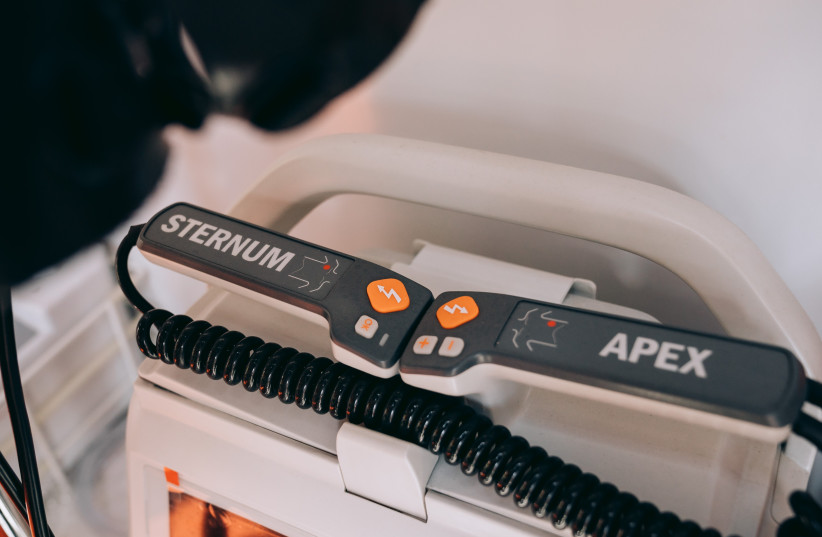Defibrillators that can shock a patient’s heart into restarting with an electric shock are finally appearing on walls around the country. But there is such a thing as a biological defibrillator to deal with irregular heartbeat (arrythmia).
Researchers at the Rambam Healthcare Campus and the Technion-Israel Institute of Technology in Haifa have succeeded for the first time in the world in using genetic engineering to treat heart rhythm disorders in their labs. The researchers were able to produce a receptor causing a biological process that regulates the electrical activity in the heart.
The patient himself will be able to activate the receptor through a tiny dose of medicine that will act only on a specific area of the heart and only in the real-time case of a heart rhythm disturbance. This, they say, is a groundbreaking development that is a kind of biological defibrillator.
Many suffer from heart rhythm disorders
Cardiac arrhythmias are characterized by a feeling of an out-of-rhythm beat, a missed beat, a too-fast beat or a slow beat that exceeds the norm – which is between 60 and 100 beats per minute. Hundreds of thousands of Israelis suffer from heart rhythm disorders, most of them as a result of a disruption in electrical activity. This causes chest pain, shortness of breath, fatigue, dizziness and weakness to the point of fainting; a heart rhythm disorder can even be life-threatening.
Researchers all over the world have been trying to find solutions to regulate the disorders, until now without success – even though there are various drugs that change the electrical activity of the heart and are used to treat arrhythmias. But these drugs affect all parts of the heart and other organs, working on both healthy and diseased cells, so their effectiveness is very limited. They also have side effects, some of which are severe and may worsen the patient’s condition and even cause death.
“Medications for the treatment of cardiac arrhythmias are ineffective and sometimes may themselves cause an arrhythmia in another area of the heart, which may be more serious than the original arrhythmia they were trying to solve,” explained Prof. Lior Gepstein, director of the cardiology department and director of the research department at the Rambam. For this reason, treatment for atrial fibrillation often boils down to giving anti-coagulant drugs – to prevent the formation of life-threatening clots instead of trying to deal with the problem itself.
The research has been published in the journal Circulation Research under the title “Chemogenetics for Gene-Therapy-based Targeted Cardiac Electrophysiological Modulation.”
“Our solution is to genetically engineer a receptor and insert it into a certain point in the heart where it will connect to specific cells responsible for the electrical activity of the heart but will be in a dormant state. The goal is for the patient to take the drug himself, when the arrythmia is taking place. The drug will connect to the receptor, which will wake him up and activate the cells that regulate the electrical activity only in the place where the arrhythmia occurs and not in the entire heart,” adds Yehuda Wexler, a doctoral student in Gepstein’s lab who led the research.
The findings were presented for the first time at the recent annual research day conducted by Rambam’s research department within the framework of which 120 studies were submitted that are in various stages of research. All of them were launched after the doctors recognized a real need that emerged from the field.
The study encourages doctors to engage not only in basic research to find biological mechanisms for diseases, but also to carry out translational research that finds practical solutions for various health conditions. “To this end, Rambam devotes comprehensive resources to achieving this goal. In recent years, we have seen the formation of connections among the hospitals, academia and industry that have led to inventions in the field of pharmaceuticals and medical devices, and we will continue to encourage this,” Gepstein declared.
The new method, when applied to humans, will offer a simple and much more effective alternative to the drugs and treatments that exist today, continued Gepstein. “Our goal is to be able to determine precisely which cells in the heart will be engineered to express the receptors – for example only cells in the heart’s ascents – and then activate them precisely with the help of a minimal dose of a drug that will not affect other cells at all. So, for example, a patient who feels atrial fibrillation will take the drug when he feels the fibrillation. It will have a highly effective effect only where the rate of electrical activity needs to be changed – without disrupting the activity in any other cell in the heart or body.”
The researchers demonstrated that by controlling the receptor and by changing the dose of a drug, the rate of electrical activity in heart cells can be changed in vitro (in a controlled environment) and also in three-dimensional tissue of heart cells. “We created tissues that are made partly from normal heart cells and partly from engineered heart cells with the receptor and showed how in a neutral state, the natural heart cells determine the tissue’s electrical rhythm. But when the drug is added, the engineered cells dictate the electrical rhythm,” Wexler said.
The researchers also showed that the engineered cells can be transplanted into the heart of a rat and that in the presence of the drug –which is a well-known drug already approved for human use by the US Food and Drug Administration (FDA) – these cells dictate the electrical rhythm.




